|
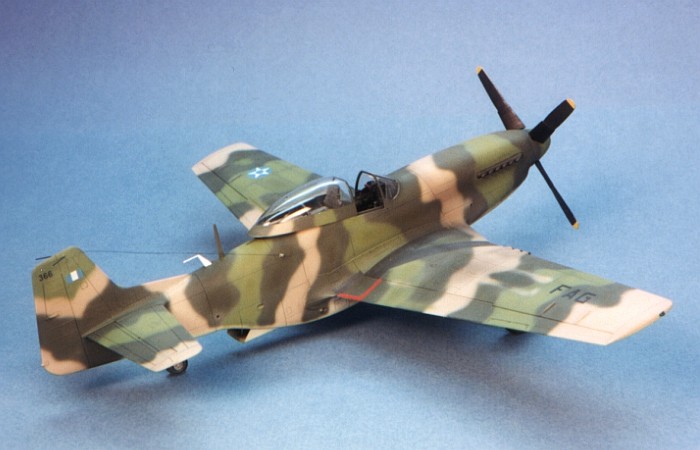
|
|
North American F_51D Mustang |
by David W. Aungst

Hasegawa's 1/48 scale P-51D Mustang is
available online from Squadron.com
"Not another blinking Mustang model -- hey, wait -- what a strange
camouflage. That does not look like W.W.II."
I am not sure when, but somewhere along the way I got interested in
W.W.II aircraft that saw postwar service. I think a part of the interest
lies in the fact that these aircraft were painted into some rather
interesting paint schemes that do not fit the "accepted" general
descriptions of the aircraft as seen in W.W.II. For example, in my mind,
F4U Corsairs are supposed to be blue. Seeing a jungle camouflaged
Salvadoran machine just looks wrong to me. Likewise, P-51 (F-51)
Mustangs are supposed to be solid green or natural metal. Jungle
camouflaged Dominican Republic and Guatemalan machines also look wrong
to me.
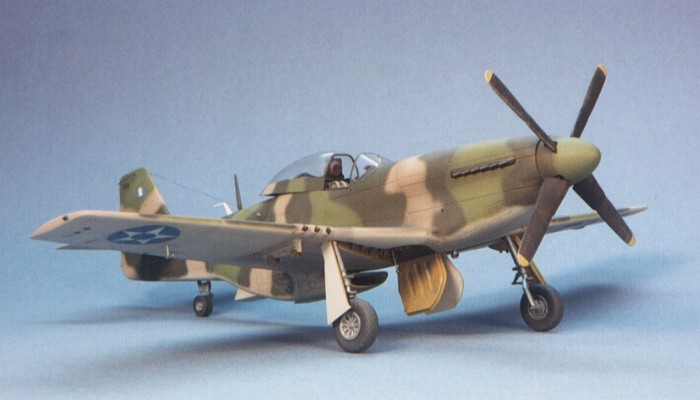
The incentive to build this model came in the form of a decal sheet I
purchased from Aztec Decals, "Latin Eagles IV", featuring Latin American
"Heavy Iron". The sheet provides markings for Honduran Corsairs,
Guatemalan Mustangs, and Mexican Thunderbolts. I bought the decal sheet
for decals to build a Honduran Corsair. But, I found I liked these
Mustang markings enough to want to commit time to building them, too.
This model represents a Mustang in the last year of its military
service, prior to being imortalized on the War Birds show circuit. The
aircraft is from the Escuadron de Caza, AB La Aurora, of the Guatamalan
Air Force, circa 1972. This jungle camouflage was unique to the Mustangs
flown in Central America.
Hasegawa's 1/48 Scale P-51D
Mustang
|
This is Hasegawa's 1/48th scale P-51D Mustang. Ever since the release
of the Tamiya kit, I had considered the Hasegawa kit to be not as good
as the Tamiya offering. I came to this conclusion without doing a very
exhaustive comparison of the kits. After building this Hasegawa kit and
comparing it more closely to the Tamiya kit, I have changed my mind and
decided that Hasegawa's Mustang is the better kit. Tamiya's deeper main
wheel wells and separate wing flaps are no match to the level of finesse
that Hasegawa has molded into their kit (IMHO).
Both kits have nicely molded cockpits.
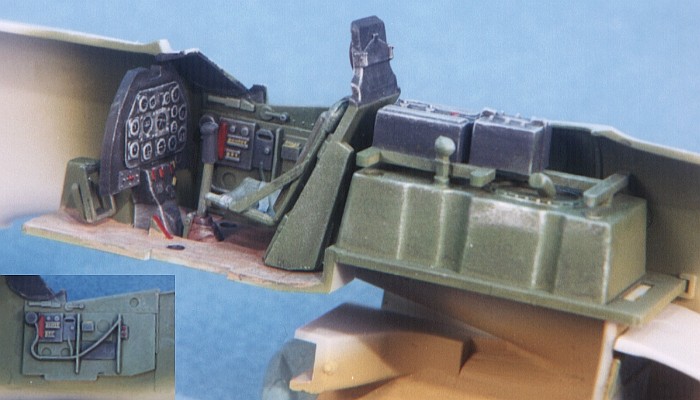
Both kits have an accurate overall shape and outline. The places I
found Hasegawa outclassing Tamiya were the little details. Tamiya
provides more simplistic moldings of the landing gear. The bracket that
mounts the main wheel well doors to the landing gear strut is a good
example. Hasegawa provides a separate piece for this in their kit.
Tamiya just molds a large squared knob on the strut in their kit.
Another example involves the main weapons pylons under the wings.
Hasegawa provides separate, well molded sway braces in their kit
(providing multiple different styles of braces based on which ordnance
you choose to hang). Tamiya molds the sway braces as large bumps on top
of the ordnance in their kit.
As a final example, the Hasegawa kit includes clear pieces for most
all of the navigation and identification lights. Tamiya provides these
as extended bumps on the wing tips and other locations that the modeler
would have to grind off and replace if they wanted clear lights.
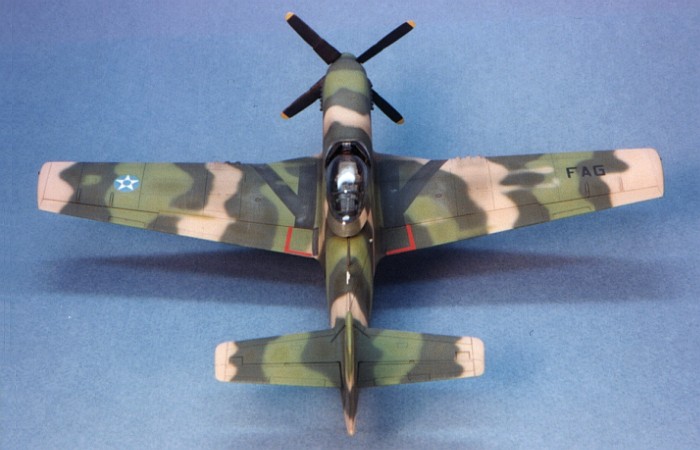
The bottom line is that I am happy I have not purchased many Tamiya
Mustangs. I will continue to buy and build Hasegawa Mustangs when the
desire befalls me.
The point of this particular model was the camouflage, so I built the
kit mostly out-of-the-box. The only changes I made were to update the
antenna fit of the airframe. The new antennas give the airframe a varied
look that helps to clarify that it is a postwar topic. I also deleted
the tail wheel well doors. The Guatemalans chose to correct a tail wheel
retraction anomoly by locking the tail wheel down and removing the wheel
well doors.
I used all Testors Model Master enamel paints on the model.
The decal instructions name the camouflage colors as Israeli Sand
(F.S.33531), Dark Green (F.S.34079), and Medium Green (F.S.34102) with a
Camouflage Gray (F.S.36622) bottom. Color pictures of these aircraft I
have found in books show what seems to be different colors. I chose to
change the colors to better match the pictures.
I custom mixed a shade of brown using Israeli Sand (F.S.33531) and
Tan (F.S.30219), mixed 2:1 (Sand to Tan). I replace Medium Green
(F.S.34102) with Interior Green (F.S.34151). I kept the Dark Green
(F.S.34079) top color and the Camouflage Gray (F.S.36622) bottom color.
I scale-effected both green colors with white, mixing both in 5:1 ratios
(Green to White). With these colors, the completed model looks more like
what I found in pictures.
It took a whole ten decals to add markings to the aircraft. I used
Slov-a-Set as a setting solution with no problems. I masked and painted
the wing walkway stripes.
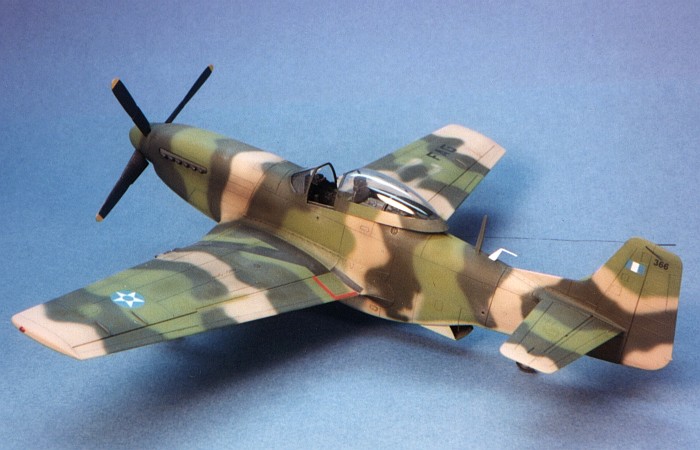
After completing the camouflage and decals, I was pleased with the
outcome and color choices. The problem was that it looked too "new",
like it was fresh from the paint shop (which it in essence was). I
decided to "distress" the camouflage a bit and apply some touch-up
painting to break up the clean lines of the camouflage.
Gloss coating and flat coating the original camouflage had slightly
tinted the original camouflage colors. Using the same colors as those I
originally painted the camouflage in, I found that they came up just
slightly lighter than the original paints. This provided me the means to
give the camouflage paints a more weathered appearance. My normal
weathering techniques then did the rest.
For weathering, I used my typical style of thinned down enamel paint
washes and air brush shading. I finished the weathering with some dry
brushing to pop out the surface details. For a more complete discussion
of what I do to weather my models, see my posting on "Weathering
Aircraft".
Newer decals by upstart companies like Aztec Decals are providing a
wide variety of different markings schemes to apply to otherwise
mundane, over-built aircraft like the Mustang, Corsair, and Thunderbolt.
It makes me wish that more Luftwaffe aircraft had survived the war and
gotten redistributed to some Third World air forces.
Aztec Decals recently announced the release of more Latin American
Mustang decals for the Dominican Republic and El Salvador. So, expect to
see some more "Postwar Warriors" from me in the future.
|
Additional
Images and Project Summary
|
Click the
thumbnails below to view images full-sized.
Click the "Back" arrow on your browser to return to this page.
|
[../photogallery/photo25668/real.htm] |
|
Project
Statistics
|
|
Completion
Date:
|
8 March 2001 |
|
Total Building
Time:
|
28.6 |
|
Research:
|
0.7 |
|
Construction:
|
8.9 |
|
Painting:
|
16.4 |
|
Decals /
Markings:
|
1.5 |
|
Extra Detailing /
Conversion:
|
1.1 |
|
Model, Description and Images Copyright ©
2001 by David Aungst
Page Created 25 September, 2001
Home
| What's New |
Features |
Gallery |
Reviews |
Reference |
Forum |
Search